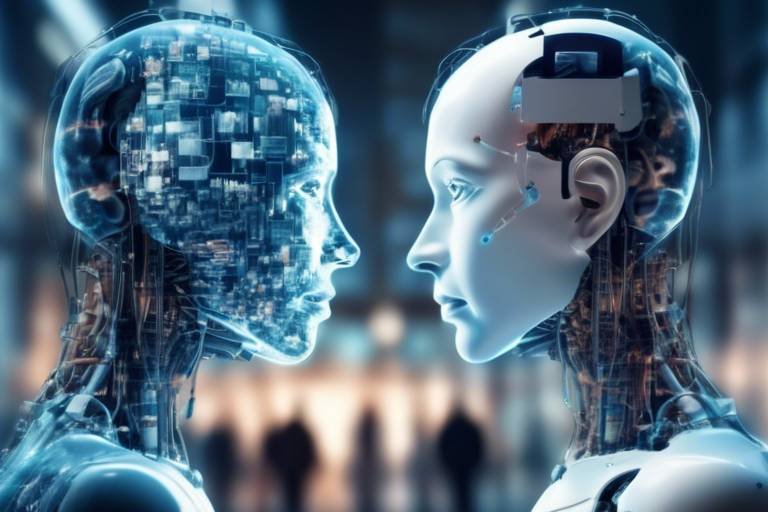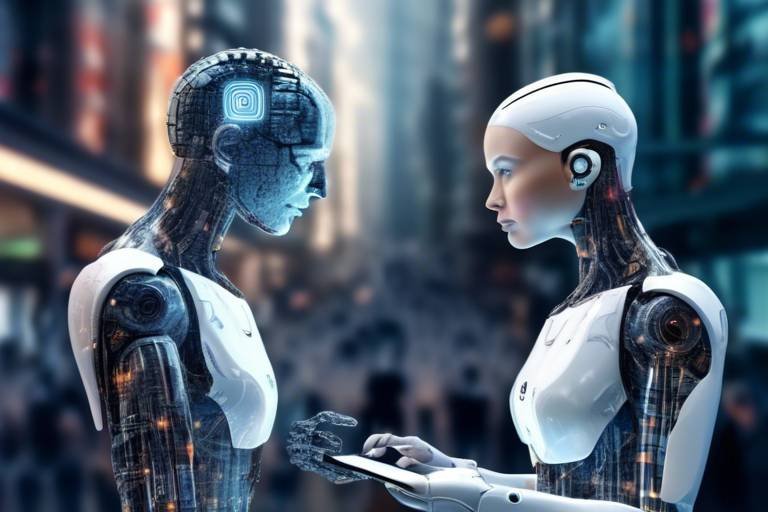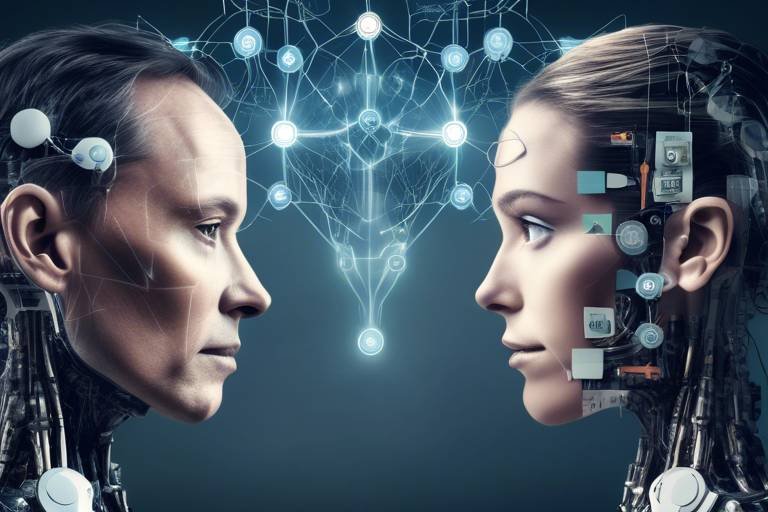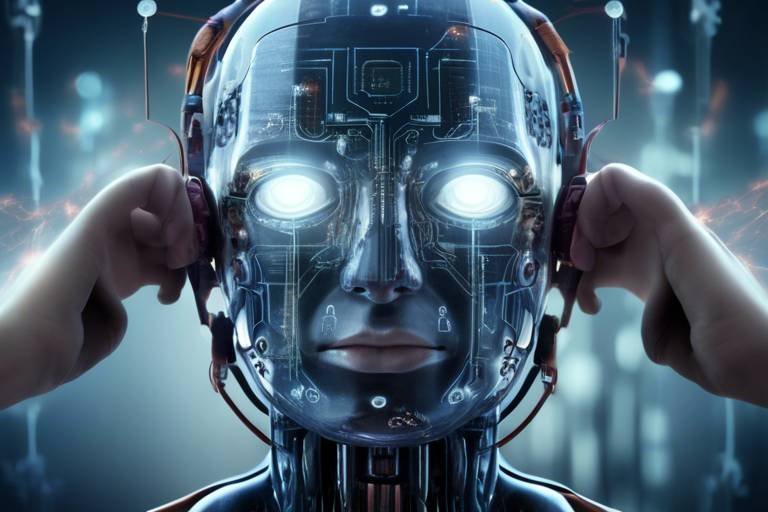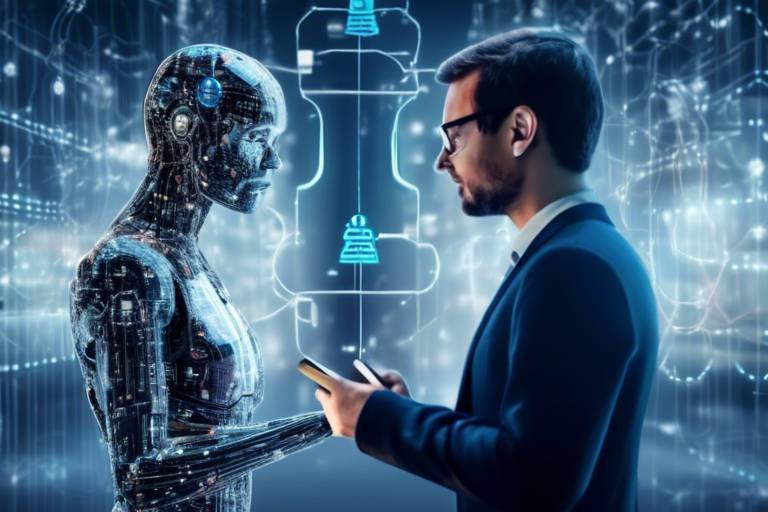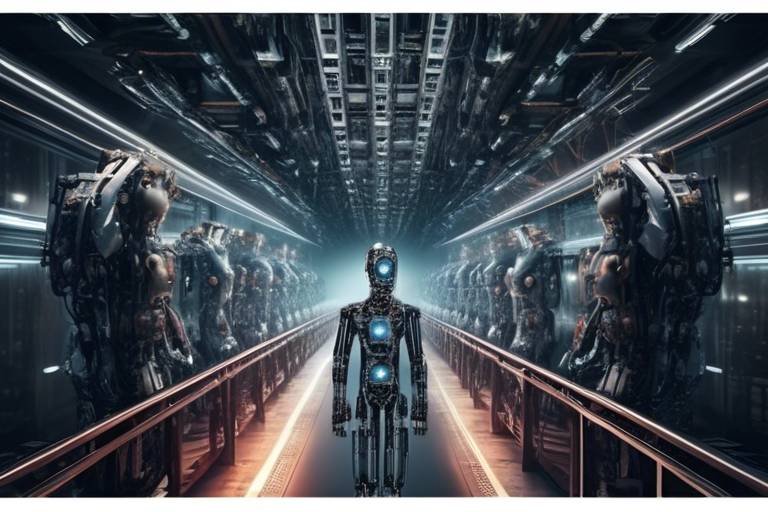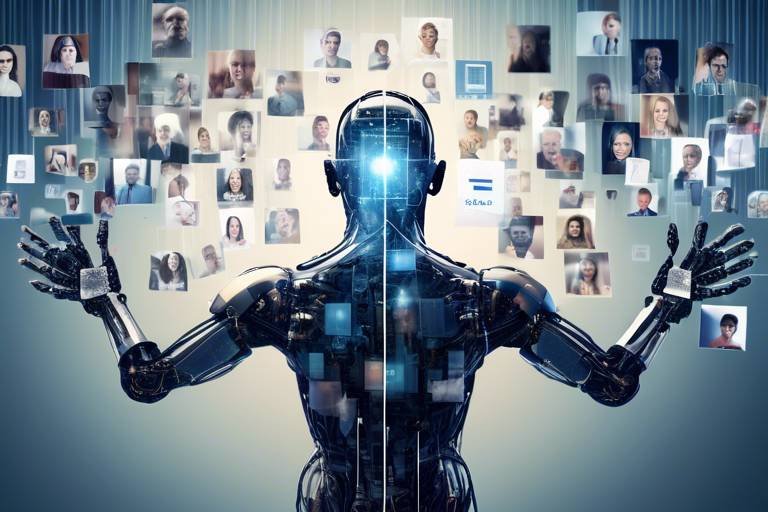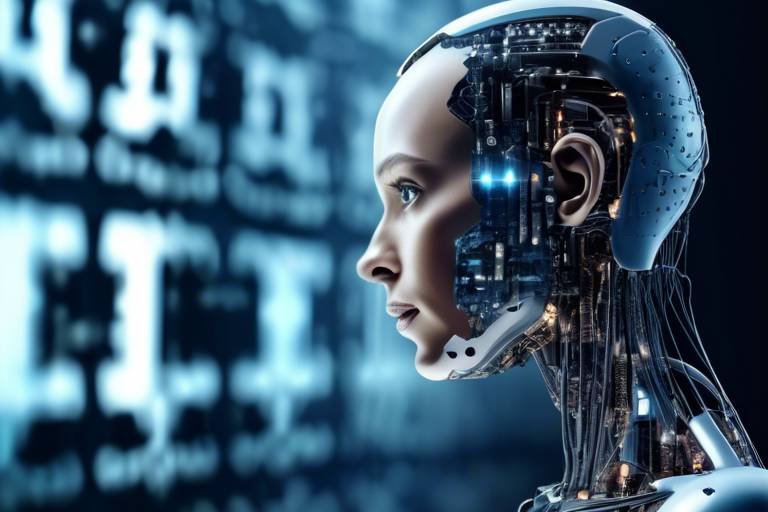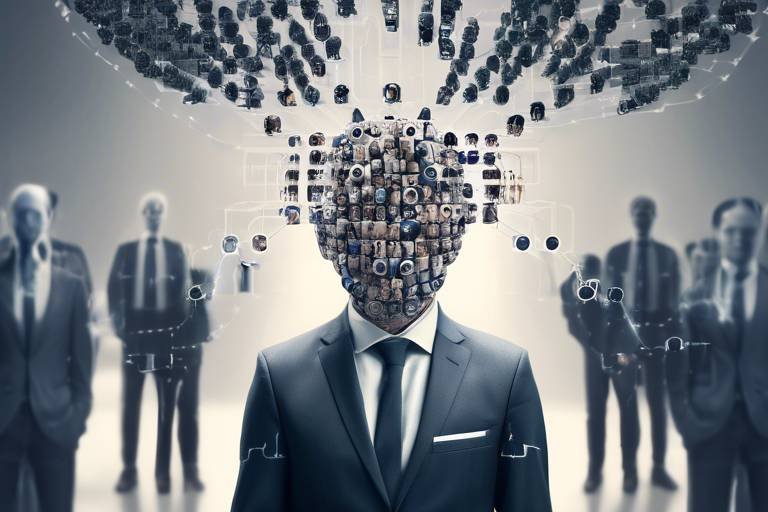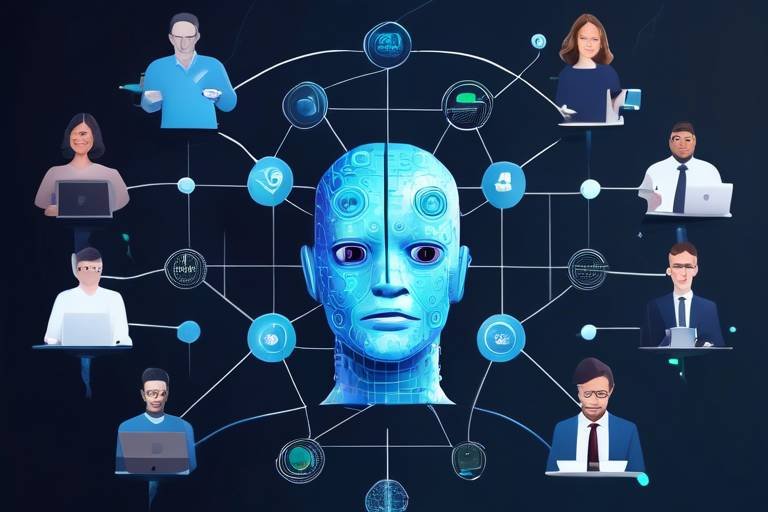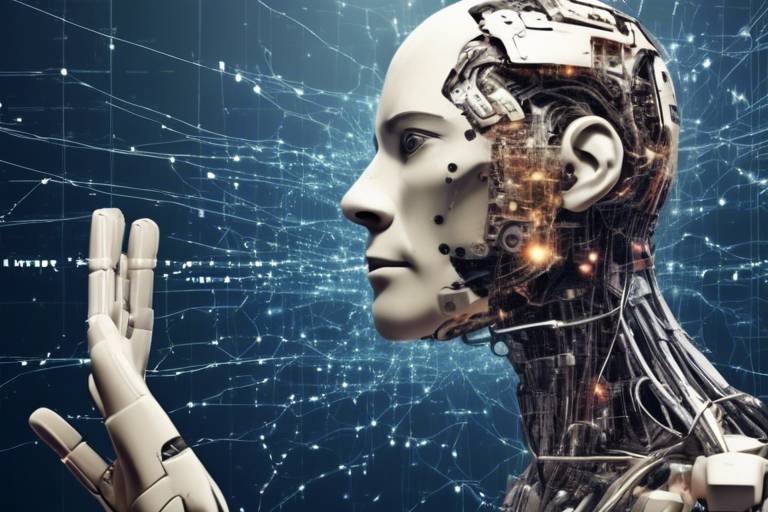AI and Human Collaboration in a Post-Covid World
The Covid-19 pandemic has acted as a powerful catalyst, accelerating the integration of artificial intelligence (AI) into our daily lives and reshaping the way we collaborate. As we emerge from the shadows of this global crisis, the relationship between humans and AI is not just evolving; it's transforming. This partnership is creating a new landscape where technology and human ingenuity work hand in hand to tackle challenges that were once deemed insurmountable. Imagine a world where AI isn't just a tool but a partner, enhancing our capabilities and enabling us to achieve greater heights together. In this article, we will explore the myriad opportunities and challenges that arise from this collaboration, shedding light on how it is revolutionizing various sectors.
The pandemic has pushed many companies to rethink their operational strategies, leading to a surge in AI adoption across various industries. From healthcare to finance, businesses are leveraging AI to improve efficiency and enhance customer experiences. For instance, telehealth services have exploded in popularity, utilizing AI to provide virtual consultations and streamline patient management. Similarly, in retail, AI-driven analytics are helping businesses understand consumer behaviors better, allowing for personalized marketing strategies. As we navigate this post-Covid world, the question arises: how can we harness AI to create even more innovative solutions?
When humans and AI systems come together, the results can be astounding. This collaborative effort not only drives productivity but also fosters creativity and better decision-making. By combining the analytical power of AI with the emotional intelligence and creativity of humans, organizations can tackle complex problems more effectively. Consider this: while AI can crunch numbers and analyze data at lightning speed, it is the human touch that brings empathy and understanding into the equation. This synergy allows for optimal outcomes, especially in challenging environments.
One of the most significant advantages of AI is its ability to automate repetitive tasks. This automation liberates human workers, allowing them to focus on strategic and creative aspects of their roles. For example, in manufacturing, AI-powered robots can handle assembly line tasks, while human workers can concentrate on quality control and innovation. The result? A significant boost in overall productivity. According to a recent study, organizations that have integrated AI into their workflows have reported a 30% increase in efficiency.
Let's take a closer look at some real-world examples of businesses that have successfully integrated AI solutions:
| Company | Industry | AI Solution | Outcome |
|---|---|---|---|
| Amazon | Retail | Automated Warehousing | Reduced operational costs by 20% |
| IBM | Technology | Watson AI | Improved customer service response time by 50% |
| Siemens | Manufacturing | Predictive Maintenance | Decreased downtime by 40% |
Despite the clear advantages, organizations face several hurdles when adopting AI technologies. Resistance to change is a significant barrier, as many employees may fear job displacement or struggle to adapt to new systems. Moreover, concerns about data privacy and security cannot be overlooked. Organizations must also invest in upskilling their workforce to work alongside AI, ensuring that employees are equipped with the necessary skills to thrive in this new environment.
AI systems are not just about automation; they also excel at analyzing vast amounts of data quickly. This capability provides organizations with insights that support informed decision-making. In a world where data is abundant, the ability to sift through information and highlight key trends is invaluable. For instance, in finance, AI can analyze market fluctuations and predict future trends, helping investors make strategic decisions. As we continue to navigate a rapidly changing landscape, the role of AI in decision-making will only grow more critical.
As AI becomes more integrated into society, ethical considerations surrounding its use are paramount. Issues of bias, transparency, and accountability must be addressed to ensure responsible development and deployment of AI technologies. Without a robust ethical framework, the risks of misuse or unintended consequences could be significant.
It is crucial to understand how biases can inadvertently seep into AI algorithms. These biases often stem from the data used to train AI systems. If the data is not diverse or representative, the AI's outputs can perpetuate existing inequalities. To create fair and equitable AI solutions, organizations must prioritize the use of diverse data sets and continuously monitor their AI systems for bias.
Organizations must prioritize transparency in AI decision-making processes. This transparency builds trust with users and stakeholders, ensuring ethical practices in AI deployment. Establishing accountability measures is also essential; organizations should have clear guidelines on who is responsible for AI-driven decisions. By doing so, they can foster a culture of responsibility and ethical AI use.
The collaboration between humans and AI is reshaping the workforce. As we look to the future, it’s clear that new skills and roles will emerge, necessitating a redefined understanding of work in a technology-enhanced environment. This evolution paves the way for future innovations and presents exciting opportunities for those willing to adapt and embrace change.
- What industries are most affected by AI? AI is impacting various sectors, including healthcare, finance, retail, and manufacturing.
- How can businesses overcome resistance to AI adoption? Businesses can overcome resistance by providing training, highlighting the benefits of AI, and ensuring open communication with employees.
- What are the ethical concerns surrounding AI? Key concerns include bias in algorithms, data privacy, and the need for transparency and accountability in AI systems.

The Rise of AI in Various Industries
The Covid-19 pandemic acted as a catalyst for change, propelling artificial intelligence (AI) into the spotlight across various industries. Before the pandemic, AI was often viewed as a futuristic concept, but today, it has become a necessity for businesses striving to survive and thrive in a rapidly evolving landscape. Organizations have realized that leveraging AI is not just about keeping up with trends; it's about enhancing efficiency, improving customer experiences, and driving innovation.
From healthcare to finance, the integration of AI technologies has reshaped operations and interactions. In the healthcare sector, for instance, AI has been instrumental in streamlining patient care through predictive analytics and telemedicine. Hospitals are now using AI to analyze patient data, predict potential health risks, and even manage resources more effectively. This not only improves patient outcomes but also reduces costs, which is especially crucial in a post-pandemic world where every penny counts.
Similarly, the retail sector has seen a significant transformation. With the surge in online shopping during lockdowns, retailers turned to AI to enhance their e-commerce platforms. AI-driven chatbots provide 24/7 customer service, while machine learning algorithms analyze shopping behaviors to offer personalized recommendations. This level of customization leads to increased customer satisfaction and loyalty, proving that AI is not just a tool but a game-changer in how businesses engage with their clients.
Moreover, the manufacturing industry has embraced AI to optimize production processes. Smart factories equipped with AI technologies can monitor machinery in real-time, predict failures before they happen, and automate repetitive tasks. This not only boosts productivity but also ensures a safer working environment, as AI can take over hazardous tasks that pose risks to human workers. The result? A more agile and resilient manufacturing sector capable of adapting to market demands swiftly.
But it's not just about efficiency and productivity; AI is also fostering innovation. In the financial sector, for example, AI algorithms are being used to detect fraudulent activities by analyzing transaction patterns and flagging anomalies. This proactive approach not only protects businesses but also enhances trust among consumers. As we move forward, it’s clear that the rise of AI in various industries is not a fleeting trend but a fundamental shift that will define the future of work.
In summary, the pandemic has accelerated the adoption of AI technologies, reshaping how businesses operate and interact with customers. As organizations harness the power of AI, they are not only enhancing efficiency but also paving the way for innovative solutions that can address complex challenges. The journey of AI's rise is just beginning, and its potential to transform industries is boundless.
- What industries are most affected by AI? AI is significantly impacting healthcare, finance, retail, and manufacturing, among others.
- How does AI improve customer experience? AI enhances customer experience through personalized recommendations, 24/7 support via chatbots, and predictive analytics.
- What are the challenges of implementing AI in businesses? Challenges include resistance to change, data privacy concerns, and the need for employee upskilling.
- Will AI replace human jobs? While AI will automate certain tasks, it will also create new roles that require human creativity and critical thinking.

Benefits of Human-AI Collaboration
In today’s fast-paced world, the collaboration between humans and artificial intelligence (AI) is proving to be a game-changer. But why is this partnership so essential? Well, think of AI as a supercharged assistant, one that can process and analyze data at lightning speed while humans bring creativity, emotional intelligence, and strategic thinking to the table. Together, they create a synergy that can lead to remarkable outcomes.
One of the most significant benefits of this collaboration is the enhancement of productivity. Imagine a workplace where mundane, repetitive tasks are handled by AI, allowing human workers to focus on what they do best—innovating and strategizing. This shift not only boosts efficiency but also fosters a more engaging work environment. For instance, an AI tool might handle customer inquiries, enabling employees to concentrate on building relationships and developing new products.
Furthermore, when humans and AI systems work together, the potential for creativity skyrockets. AI can analyze trends and data patterns that might go unnoticed by the human eye, offering insights that can inspire new ideas and solutions. This is especially beneficial in industries like marketing, where understanding consumer behavior is crucial. By leveraging AI's analytical capabilities, businesses can create targeted campaigns that resonate with their audience, driving engagement and sales.
Another vital aspect of human-AI collaboration is improved decision-making. AI systems can sift through vast amounts of information, providing insights that help organizations make informed choices. For example, in the healthcare sector, AI can analyze patient data to identify potential health risks, allowing doctors to make proactive decisions about treatment plans. This data-driven approach not only enhances patient care but also streamlines operations.
However, it's essential to recognize that the collaboration is not without its challenges. Organizations must ensure that their teams are equipped with the necessary skills to work alongside AI technologies. This often requires ongoing training and development, fostering a culture of continuous learning. Additionally, as AI becomes more integrated into decision-making processes, it’s crucial to maintain a balance between human intuition and machine logic. After all, while AI can provide data-driven insights, it’s the human touch that brings empathy and understanding to the decision-making table.
To illustrate the benefits of human-AI collaboration, let’s take a look at a few key areas:
| Area | Human Contribution | AI Contribution |
|---|---|---|
| Customer Service | Building relationships, addressing complex issues | Handling inquiries, providing instant responses |
| Healthcare | Patient care, treatment planning | Data analysis, risk assessment |
| Marketing | Creative campaign development, brand storytelling | Market trend analysis, consumer behavior insights |
As we move forward, the benefits of human-AI collaboration will only continue to grow. By embracing this partnership, organizations can unlock new levels of innovation and efficiency, ultimately leading to better outcomes for both businesses and their customers. So, are you ready to embrace the future of work?
- What are the main benefits of human-AI collaboration?
The main benefits include enhanced productivity, improved decision-making, and increased creativity by combining human intuition with AI's analytical capabilities.
- How can organizations prepare their workforce for AI collaboration?
Organizations can prepare by providing ongoing training, fostering a culture of continuous learning, and ensuring employees understand how to work alongside AI technologies effectively.
- What challenges might arise from human-AI collaboration?
Challenges include resistance to change, the need for upskilling employees, and ensuring a balance between human intuition and machine logic in decision-making processes.

Improving Efficiency and Productivity
In today's fast-paced world, businesses are constantly looking for ways to improve efficiency and boost productivity. The integration of artificial intelligence (AI) into everyday operations is proving to be a game changer. Imagine a workplace where mundane, repetitive tasks are taken off your plate, allowing you to focus on what truly matters—creative problem-solving and strategic planning. Sounds appealing, right? That's precisely what AI brings to the table.
AI tools can automate a variety of tasks, ranging from data entry to customer service inquiries. This automation leads to significant time savings and allows employees to dedicate their efforts to more complex and rewarding activities. For instance, in the realm of customer service, AI-powered chatbots can handle routine queries, ensuring that human agents are free to tackle more intricate issues that require a personal touch. This shift not only enhances employee satisfaction but also results in a better customer experience.
Moreover, AI's ability to analyze large datasets at lightning speed means that organizations can make data-driven decisions with confidence. This capability is particularly beneficial in sectors like finance, healthcare, and marketing, where understanding trends and patterns can lead to more informed strategies. To illustrate, consider a retail company that utilizes AI to predict inventory needs based on customer purchasing behavior. By accurately forecasting demand, the company can reduce waste and optimize stock levels, ultimately enhancing profitability.
Let's take a look at some real-world examples of how businesses have successfully integrated AI to streamline operations:
| Company | AI Implementation | Results |
|---|---|---|
| Amazon | Automated inventory management | Reduced operational costs and improved delivery times |
| Netflix | Personalized content recommendations | Increased user engagement and retention |
| IBM | AI-driven analytics for business insights | Enhanced decision-making and strategy development |
However, the journey towards enhanced efficiency through AI is not without its challenges. Organizations must navigate hurdles such as resistance to change and the need for employee training. Many employees may feel threatened by the introduction of AI, fearing that it could replace their jobs. It's crucial for leaders to communicate the value of AI as a tool that complements human effort rather than one that replaces it. By fostering a culture of collaboration between humans and AI, companies can alleviate fears and encourage a more productive work environment.
In conclusion, the integration of AI into the workplace is not just about automation; it's about transforming the way we work. By improving efficiency and productivity, AI empowers employees to focus on higher-level tasks that drive innovation and growth. As we continue to adapt to this new reality, embracing AI collaboration will be key to unlocking the full potential of our workforce.
- How does AI improve productivity in the workplace? AI automates repetitive tasks, allowing employees to focus on more strategic and creative aspects of their roles.
- What are some examples of AI applications in business? AI is used in customer service (chatbots), inventory management, and data analytics, among others.
- Are employees at risk of losing their jobs due to AI? While some tasks may be automated, AI is intended to complement human work, not replace it. Upskilling and collaboration are essential.

Case Studies in Automation
The impact of automation through AI technologies has been profound, with numerous organizations experiencing transformative changes in their operations. One such example is Amazon, which has revolutionized its warehouse operations by integrating AI-driven robots that assist in sorting and packing products. This not only enhances efficiency but also reduces the physical strain on human workers. Imagine a bustling warehouse where robots and humans work side by side, each performing tasks that suit their strengths. This collaboration has allowed Amazon to scale its operations significantly while maintaining high levels of customer satisfaction.
Another compelling case study is that of Siemens, a leader in industrial manufacturing. Siemens implemented AI solutions in its production lines to predict equipment failures before they occur. By using machine learning algorithms to analyze data from sensors on machinery, Siemens can schedule maintenance proactively, reducing downtime and saving costs. This approach is akin to having a personal mechanic who knows your car’s quirks better than you do, ensuring that it runs smoothly without unexpected breakdowns. The results have been impressive, with a reported decrease in maintenance costs by up to 30% and an increase in overall productivity.
Healthcare is another sector where automation has made significant strides. Consider the case of Mount Sinai Health System in New York, which adopted AI to streamline its patient intake process. By employing chatbots to handle initial patient queries and scheduling, the hospital has been able to reduce wait times and enhance the overall patient experience. This innovative use of technology allows healthcare professionals to focus more on patient care rather than administrative tasks, echoing the idea that technology should augment human capabilities rather than replace them.
These examples illustrate the tangible benefits of automation across various fields. However, it’s essential to recognize that successful implementation requires careful planning and a willingness to adapt. Organizations must ensure that their workforce is equipped with the necessary skills to work alongside AI technologies. This collaborative approach not only maximizes efficiency but also fosters a culture of innovation and continuous improvement.
In summary, the case studies of Amazon, Siemens, and Mount Sinai Health System highlight the diverse applications of AI in automation. They serve as a reminder that when humans and machines collaborate effectively, the potential for growth and efficiency is virtually limitless.
- What is AI automation? - AI automation refers to the use of artificial intelligence technologies to perform tasks that would typically require human intervention, enhancing efficiency and accuracy.
- How does AI improve productivity? - AI improves productivity by automating repetitive tasks, allowing human workers to focus on more strategic and creative aspects of their jobs.
- What are the challenges of implementing AI? - Some challenges include resistance to change, data privacy concerns, and the need for upskilling employees to work alongside AI systems.
- Can AI replace human jobs? - While AI can automate certain tasks, it often complements human work rather than completely replacing it, leading to new roles and opportunities.

Challenges in Implementation
The integration of AI into businesses may seem like a straightforward process, but in reality, it presents a myriad of challenges that organizations must navigate. One major hurdle is the resistance to change. Many employees view AI as a threat to their jobs rather than a tool that can enhance their capabilities. This fear can lead to pushback against new technologies, creating a barrier to successful implementation. It's essential for organizations to foster a culture of acceptance and understanding around AI, emphasizing that these tools are designed to support, not replace, human workers.
Another significant challenge revolves around data privacy concerns. In the wake of increasing regulations like GDPR and CCPA, organizations must ensure that their AI systems comply with data protection laws. This entails not only safeguarding sensitive information but also being transparent about how data is used in AI algorithms. Failure to address these concerns can lead to legal repercussions and a loss of trust from customers.
Additionally, the need for upskilling employees cannot be overstated. As AI technologies evolve, so too must the skill sets of the workforce. Companies must invest in training programs that equip employees with the knowledge and skills to work alongside AI systems effectively. This investment is crucial; without it, organizations risk falling behind in a rapidly changing landscape where AI plays an increasingly vital role.
To illustrate these challenges, consider the following table that outlines the primary obstacles organizations face in implementing AI:
| Challenge | Description |
|---|---|
| Resistance to Change | Employees may fear job loss and resist adopting AI technologies. |
| Data Privacy Concerns | Compliance with data protection regulations is essential to maintain trust. |
| Upskilling Employees | Training is necessary to ensure the workforce can effectively work with AI. |
In summary, while the potential of AI is immense, organizations must address these challenges head-on to ensure a smooth transition into an AI-enhanced future. By fostering a positive attitude towards change, prioritizing data privacy, and investing in employee training, businesses can successfully harness the power of AI and reap its benefits.
- What are the main challenges of implementing AI in the workplace?
The key challenges include resistance to change, data privacy concerns, and the need for upskilling employees. - How can organizations overcome resistance to AI?
By fostering a culture of acceptance and emphasizing the benefits of AI as a supportive tool rather than a replacement. - Why is data privacy important in AI implementation?
Compliance with data protection regulations is essential to maintain customer trust and avoid legal issues. - What role does employee training play in AI adoption?
Training ensures that employees are equipped with the necessary skills to work alongside AI technologies effectively.

Enhancing Decision-Making Processes
In today’s fast-paced business landscape, the ability to make informed decisions quickly is more crucial than ever. This is where the power of artificial intelligence (AI) comes into play. Imagine having a super-smart assistant that can sift through mountains of data in seconds, providing you with insights that would take a human team days or even weeks to uncover. Sounds like a dream, right? Well, it's becoming a reality!
AI systems excel at analyzing vast datasets, identifying patterns, and generating predictions, which can significantly enhance decision-making processes across various sectors. For instance, in the healthcare industry, AI algorithms can analyze patient data to predict potential health risks, allowing medical professionals to intervene early. Similarly, in finance, AI can assess market trends and assist traders in making informed investment choices. The implications are enormous!
One of the key benefits of AI in decision-making is its ability to eliminate biases that often cloud human judgment. While humans are inherently influenced by emotions and personal experiences, AI systems, when designed correctly, can provide a more objective viewpoint. This is especially important in sectors like hiring, where biases can lead to unfair practices. By leveraging diverse data sets, organizations can ensure that their AI systems promote fair and equitable outcomes.
However, it’s important to remember that AI is not a magic bullet. While it can provide invaluable insights, the ultimate decision-making still rests with humans. This partnership between AI and human intelligence creates a powerful synergy, where data-driven insights can inform strategic decisions while human intuition and creativity guide the final choices. Think of it like a seasoned chef using a high-tech oven: the oven can cook the food perfectly, but it’s the chef who adds the unique flavors and presentation that make the dish special.
To illustrate the transformative impact of AI on decision-making, consider the following table that outlines how different industries are utilizing AI to enhance their decision-making processes:
| Industry | AI Application | Benefits |
|---|---|---|
| Healthcare | Predictive analytics for patient care | Improved patient outcomes through early intervention |
| Finance | Market trend analysis | Informed investment strategies and risk management |
| Retail | Customer behavior analysis | Personalized marketing and inventory optimization |
| Manufacturing | Supply chain optimization | Reduced costs and improved efficiency |
As we continue to integrate AI into our decision-making processes, it’s essential to foster a culture that embraces this technology while also recognizing its limitations. Organizations must prioritize training employees on how to interpret AI-generated insights effectively. After all, the best decisions come from a combination of data-driven insights and human experience.
In conclusion, enhancing decision-making processes through AI is not just about adopting new technology; it’s about reshaping how we think, collaborate, and innovate. By harnessing the strengths of both AI and human intelligence, we can unlock new levels of creativity and efficiency, paving the way for a brighter future.
- What is the role of AI in decision-making? AI analyzes large datasets to provide insights that help humans make informed decisions faster.
- Can AI eliminate biases in decision-making? While AI can help reduce biases, it is crucial to use diverse data sets and maintain human oversight.
- How can organizations train employees to work with AI? Organizations can implement training programs focused on data interpretation and the ethical use of AI technologies.
- What are the risks of relying too much on AI for decision-making? Over-reliance on AI can lead to a lack of critical thinking and creativity, as well as potential ethical issues if not managed properly.

The Ethical Implications of AI
As we dive deeper into the integration of artificial intelligence in our daily lives, the ethical implications surrounding its use become increasingly significant. The rapid advancement of AI technologies raises important questions about bias, transparency, and accountability. These are not just technical challenges; they are fundamental issues that can shape the future of our society. As AI systems become more prevalent, it is crucial to ensure that they are designed and implemented in ways that are fair and equitable.
One of the most pressing concerns is bias in AI systems. AI algorithms learn from data, and if that data is biased, the outcomes will be too. For instance, if an AI system is trained on historical hiring data that reflects discrimination, it may perpetuate those biases in future hiring decisions. This can lead to unfair treatment of certain groups, exacerbating existing inequalities. To combat this, it's essential to utilize diverse datasets that represent various demographics, ensuring that AI solutions are fair and just for everyone.
Additionally, the transparency of AI decision-making processes is paramount. Users and stakeholders must understand how AI systems arrive at their conclusions. Imagine if you received a rejection from a job application, but the reason behind it was hidden in the complex workings of an AI algorithm. This lack of clarity can breed distrust and skepticism. Organizations must prioritize transparency by providing clear explanations of how AI systems function and the rationale behind their decisions. This can help build trust among users and ensure that AI is viewed as a tool for empowerment rather than oppression.
Accountability is another critical aspect of ethical AI. Who is responsible when an AI system makes a mistake? Establishing accountability measures is essential to ensure that organizations take responsibility for the outcomes of their AI systems. This includes creating frameworks that outline clear lines of accountability and ensuring that there are consequences for unethical practices. By doing so, we can foster a culture of responsibility and ethical use of AI technologies.
To summarize, the ethical implications of AI are multifaceted and require a concerted effort from all stakeholders involved. Addressing bias, enhancing transparency, and establishing accountability are crucial steps in ensuring that AI technologies are developed and deployed responsibly. As we navigate this rapidly evolving landscape, we must prioritize ethical considerations to harness the full potential of AI while safeguarding our values and principles.
- What are the main ethical concerns regarding AI?
The primary ethical concerns include bias, transparency, and accountability in AI systems. - How can bias in AI be mitigated?
By using diverse datasets and continuously monitoring AI systems for biased outcomes. - Why is transparency important in AI?
Transparency helps build trust between users and AI systems, ensuring users understand how decisions are made. - Who is responsible for AI decisions?
Organizations must establish accountability measures to ensure responsible use of AI technologies.

Addressing Bias in AI Systems
As we dive deeper into the world of artificial intelligence, one pressing issue that cannot be overlooked is the bias inherent in AI systems. Bias can sneak into AI algorithms in various ways, often as a result of the data used to train these systems. If the data reflects historical inequalities or prejudices, the AI can perpetuate or even exacerbate these biases, leading to unfair outcomes. For instance, if an AI system is trained on data that predominantly features one demographic, it may struggle to accurately recognize or serve individuals from other backgrounds. This is not just a technical flaw; it has real-world implications that can affect hiring practices, loan approvals, and even criminal justice.
To effectively tackle this issue, it’s crucial to understand how biases emerge in AI. One significant factor is the data selection process. If the data collected is not diverse or representative of the population it aims to serve, the resulting AI models will likely reflect those limitations. Therefore, organizations must prioritize the use of diverse data sets that encompass various demographics, ensuring that AI systems are trained on a broad spectrum of information.
Moreover, the development of AI should involve a multidisciplinary approach, bringing together experts from various fields such as ethics, sociology, and data science. This collaborative effort can help in identifying potential biases early in the development process. For example, companies can conduct bias audits on their algorithms, assessing how different demographic groups are impacted by AI decisions. By implementing regular checks and balances, organizations can continuously improve their AI systems and minimize bias.
Additionally, fostering an environment of transparency is vital. Organizations need to be open about how their AI systems make decisions. This transparency not only builds trust with users but also allows for external scrutiny, which can help identify and rectify biases. For instance, if a company uses an AI tool for recruitment, it should be clear about the criteria the AI uses to evaluate candidates. This level of openness can empower individuals to challenge decisions they believe are biased or unfair.
In summary, addressing bias in AI systems is a multifaceted challenge that requires a concerted effort from organizations. By utilizing diverse data sets, conducting bias audits, fostering transparency, and encouraging interdisciplinary collaboration, we can work towards creating AI systems that are not only effective but also fair and equitable. The journey towards unbiased AI is ongoing, but with the right strategies in place, we can make significant strides in ensuring that AI serves all segments of society justly.
- What is bias in AI? Bias in AI refers to the presence of prejudiced outcomes that arise from the data used to train AI systems, which can lead to unfair treatment of certain groups.
- How can organizations reduce bias in AI? Organizations can reduce bias by using diverse datasets, conducting regular audits of AI algorithms, and ensuring transparency in decision-making processes.
- Why is transparency important in AI? Transparency is crucial because it builds trust with users and allows for external scrutiny, which can help identify and correct biased outcomes.
- Can AI be completely unbiased? While it may be challenging to create completely unbiased AI, significant efforts can be made to minimize bias and create fairer systems.

Establishing Accountability and Transparency
As artificial intelligence becomes an integral part of our daily lives, the demand for accountability and transparency in AI systems is more critical than ever. With algorithms making decisions that affect everything from hiring practices to loan approvals, ensuring that these systems operate fairly and responsibly is paramount. But how can organizations achieve this? It starts with a commitment to openness and a willingness to engage with stakeholders about how AI systems function.
One of the main challenges in establishing accountability is the black box nature of many AI systems. Often, even the developers of these algorithms struggle to explain how decisions are made. This lack of clarity can lead to mistrust among users and stakeholders. To combat this, organizations must prioritize transparency in their AI processes. This means providing clear documentation on how algorithms are built, the data sets used, and the logic behind decision-making processes. By demystifying AI, businesses can foster a culture of trust and collaboration.
Moreover, establishing accountability involves creating frameworks that hold organizations responsible for the outcomes of their AI systems. This can include:
- Regular audits of AI systems to ensure they are functioning as intended.
- Implementing feedback mechanisms that allow users to report issues or discrepancies.
- Developing clear guidelines on the ethical use of AI, including consequences for violations.
Additionally, organizations should consider forming diverse oversight committees that include stakeholders from various backgrounds. This diversity can help ensure that different perspectives are considered in AI development and deployment, ultimately leading to more equitable outcomes. When everyone has a seat at the table, the likelihood of bias decreases, and the overall integrity of the AI system improves.
In conclusion, the journey toward accountability and transparency in AI is ongoing. It requires a concerted effort from organizations to be open about their practices and to be held accountable for the outcomes of their AI systems. As we continue to navigate this complex landscape, fostering trust through transparency will not only enhance user confidence but also pave the way for more responsible AI development.
- Why is accountability important in AI? Accountability ensures that organizations take responsibility for the decisions made by AI systems, fostering trust and ethical practices.
- How can transparency be achieved in AI? Transparency can be achieved by providing clear documentation about AI algorithms, the data used, and the decision-making processes involved.
- What role do diverse oversight committees play? Diverse oversight committees bring various perspectives, helping to identify and mitigate biases in AI systems, ultimately leading to fairer outcomes.
- What are the consequences of failing to establish accountability? Failing to establish accountability can lead to mistrust, ethical violations, and potential legal ramifications for organizations.

The Future of Work in an AI-Driven World
As we stand on the brink of a new era, the collaboration between humans and artificial intelligence is not just a trend; it’s a profound transformation that is reshaping the workforce. Imagine walking into an office where your AI assistant knows your preferences better than your colleagues do. Sounds futuristic, right? But this is the reality we are heading towards. The integration of AI into our daily work lives brings a myriad of opportunities and challenges that we must navigate thoughtfully.
In this AI-driven world, the nature of work is evolving. Traditional roles are being redefined, and new opportunities are emerging that require a different set of skills. For instance, jobs that involve repetitive tasks are increasingly being automated, allowing human workers to focus on more strategic and creative endeavors. This shift not only enhances productivity but also fosters a more engaging work environment where creativity can flourish. Just think about it: instead of spending hours on data entry, employees can now leverage AI tools to gain insights and make decisions that drive innovation.
However, with great power comes great responsibility. As organizations adapt to this new landscape, they must also consider the skills required for the future workforce. Upskilling and reskilling employees become paramount. Companies are investing in training programs that equip their staff with the necessary skills to work alongside AI technologies effectively. This is not merely about technical skills; it’s about fostering a mindset that embraces change and innovation. In fact, according to a recent study, organizations that prioritize continuous learning and development are more likely to thrive in an AI-enhanced environment.
| Skill Type | Importance in AI-Driven Work |
|---|---|
| Technical Skills | Understanding AI systems and data analysis. |
| Creative Skills | Generating innovative ideas and solutions. |
| Soft Skills | Collaboration, communication, and adaptability. |
Moreover, the workplace is becoming increasingly flexible. Remote work is no longer just a temporary solution; it’s becoming a permanent fixture in many industries. AI tools facilitate this transition by enabling seamless communication and collaboration among teams, regardless of their physical location. Imagine being able to brainstorm ideas with colleagues across the globe in real-time, all thanks to AI-driven platforms that enhance connectivity and productivity. This flexibility not only boosts employee satisfaction but also opens up a wider talent pool for organizations, allowing them to recruit the best minds, regardless of geography.
Yet, as we embrace these advancements, we must also be vigilant about the ethical implications of AI in the workplace. Questions of bias, privacy, and job displacement loom large. How do we ensure that AI systems are fair and equitable? How do we protect employee data while leveraging AI for productivity? These are critical issues that organizations must address to maintain trust and integrity in their operations.
In conclusion, the future of work in an AI-driven world is filled with potential and promise. By embracing collaboration between humans and AI, organizations can unlock new levels of creativity, efficiency, and innovation. However, this journey requires a commitment to ongoing learning, ethical practices, and a willingness to adapt to the ever-changing landscape. As we look forward, the question remains: are we ready to seize the opportunities that lie ahead?
- What skills will be most important in an AI-driven workplace? Skills such as technical proficiency, creativity, and soft skills like communication and adaptability will be crucial.
- How can organizations prepare their workforce for an AI-enhanced future? Companies should invest in training programs and foster a culture of continuous learning to equip employees with the necessary skills.
- What are the ethical concerns surrounding AI in the workplace? Issues like bias, privacy, and job displacement must be addressed to ensure responsible AI implementation.
- Will remote work continue to be a trend in the future? Yes, the flexibility of remote work is likely to remain, supported by AI tools that enhance collaboration.
Frequently Asked Questions
- What is the role of AI in post-Covid recovery?
AI plays a crucial role in helping businesses recover by streamlining operations, enhancing customer interactions, and providing data-driven insights. It enables organizations to adapt quickly to changing market conditions and consumer needs, ultimately driving efficiency and innovation.
- How can AI improve workplace productivity?
AI improves workplace productivity by automating repetitive tasks, allowing employees to focus on strategic and creative endeavors. This shift not only boosts efficiency but also enhances job satisfaction, as workers can engage in more meaningful work rather than mundane tasks.
- What are some challenges organizations face when implementing AI?
Organizations often encounter several challenges when implementing AI, including resistance to change from employees, concerns about data privacy, and the need for upskilling the workforce to effectively collaborate with AI technologies. Addressing these challenges is vital for successful integration.
- How does AI enhance decision-making processes?
AI enhances decision-making by analyzing vast amounts of data at lightning speed, providing organizations with actionable insights. This capability allows businesses to make informed decisions quickly, helping them navigate complex challenges and seize opportunities in a fast-paced environment.
- What ethical considerations are associated with AI?
As AI becomes more prevalent, ethical considerations such as bias, transparency, and accountability are increasingly important. Organizations must ensure that their AI systems are developed responsibly and that they prioritize fairness and trustworthiness in their decision-making processes.
- How can organizations address bias in AI systems?
Organizations can address bias in AI systems by using diverse and representative data sets during the training phase. Additionally, continuous monitoring and evaluation of AI algorithms are essential to identify and mitigate any biases that may arise over time.
- What does the future of work look like in an AI-driven world?
The future of work in an AI-driven world involves a shift in skills and roles as humans collaborate more closely with AI technologies. This collaboration will redefine job functions, create new opportunities, and necessitate ongoing learning and adaptation to keep pace with technological advancements.

